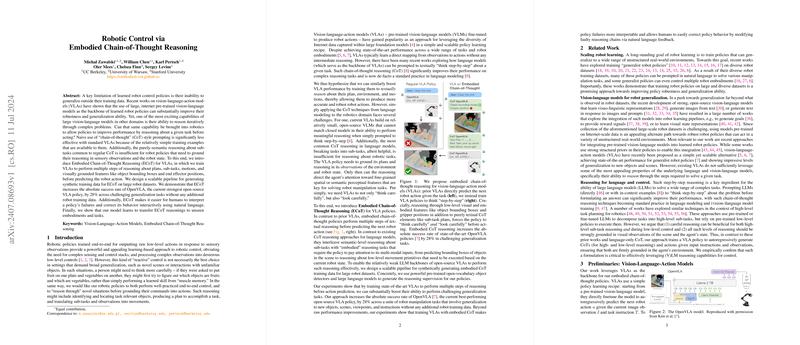Robotic Control via Embodied Chain-of-Thought Reasoning
This paper proposes a novel approach to improve generalization in robotic control policies through Embodied Chain-of-Thought (ECoT) reasoning. The key advancement lies in training Vision-Language-Action (VLA) models to perform iterative reasoning about tasks before determining the robot's actions. This method addresses the challenge of generalization in robot policies by integrating a sequential reasoning process grounded in sensory observations and robot state.
The main contributions of this work include:
- Introduction of Embodied Chain-of-Thought Reasoning:
- The authors introduce ECoT, where VLAs are trained not only to predict actions but also to reason about plans, sub-tasks, motions, and visual features. This approach aims to leverage the reasoning capabilities of large vision-LLMs, traditionally used in text-based tasks, for robotic control.
- Scalable Data Generation Pipeline:
- A scalable pipeline is designed to generate synthetic training data for ECoT using large robot datasets. This pipeline employs pre-trained open-vocabulary object detectors and LLMs to create labeled datasets that the VLA policies can learn from.
- Empirical Validation and Performance Improvements:
- The ECoT policies significantly outperform existing state-of-the-art VLA policies, notably increasing the absolute success rate of the OpenVLA by 28% across challenging generalization tasks. This improvement underscores the effectiveness of integrating embodied reasoning into VLA models.
Detailed Contributions and Results
Embodied Chain-of-Thought Reasoning Steps
The authors designed ECoT to follow a structured reasoning sequence:
- Task Interpretation and Planning: Rephrasing the task instruction and generating a high-level plan.
- Sub-task Identification: Determining the next sub-task based on the current state of the environment and the robot.
- Movement Primitives: Predicting low-level movements that the robot needs to perform.
- Spatial Reasoning: Identifying and reasoning about objects and their spatial relations in the environment, including bounding boxes and gripper positions.
This structured approach ensures that the reasoning process is thorough and grounded in the robot's sensory inputs, rather than being purely semantic.
Data Generation Pipeline
Generating ECoT training data involves multiple steps:
- Scene Descriptions: Using pre-trained VLMs (e.g., Prismatic-7B) to generate detailed descriptions of the scene.
- Bounding Box Predictions: Applying Grounding DINO to detect objects and their bounding boxes based on these descriptions.
- Movement Primitives: Classifying the robot's movements into predefined primitives using proprioceptive data.
- High-Level Reasoning and Plan: Utilizing LLMs, such as Gemini, to generate reasoning chains, including high-level plans and sub-tasks.
By automating this process, the authors could efficiently generate large-scale datasets needed to train ECoT policies.
Experimental Evaluation
The authors conducted extensive experiments to evaluate the effectiveness of ECoT:
- Generalization to New Tasks and Environments: ECoT showed marked improvements over baseline VLAs, especially in tasks requiring broad generalization, such as novel scenes or interacting with unfamiliar objects.
- Interpreting and Correcting Policy Failures: One significant advantage of ECoT is the improved interpretability of policy failures. By inspecting the reasoning chain, one can diagnose and understand the causes of failures. This feature enables easier human intervention via natural language feedback to correct policy behaviors.
Efficiency and Practical Implementation
- Inference Speed: Although ECoT involves extensive reasoning, the authors propose optimizations such as holding parts of the reasoning fixed for several steps and asynchronous execution of high- and low-level reasoning. These optimizations help in maintaining reasonable control frequencies, making ECoT suitable for real-time applications.
Implications and Future Directions
The implications of ECoT extend both practically and theoretically in AI and robotics:
- Enhanced Generalization: ECoT demonstrates that integrating intermediate reasoning steps can substantially strengthen the generalization capabilities of robot policies, enabling them to perform well in previously unseen environments and tasks.
- Human-Robot Interaction: The ability to interpret and modify reasoning chains introduces an interactive dimension to robotic control, where human operators can provide on-the-fly corrections through natural language.
- Extending to Other Embodiments: Initial results suggest that ECoT capabilities can transfer to different robot embodiments, indicating the potential for broader applicability across diverse robotic platforms.
Future research could explore adaptive reasoning chain structures, optimizing runtime efficiency further, and expanding ECoT training to larger and more varied robot datasets to enhance its robustness and applicability.
In conclusion, the paper presents Embodied Chain-of-Thought reasoning as a promising avenue for advancing the generalization abilities of robotic control policies, bridging the gap between high-level reasoning and low-level control in complex, real-world environments.
